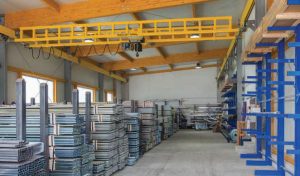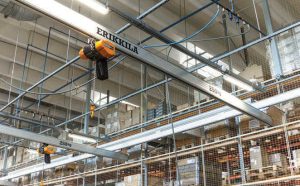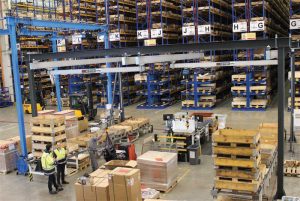Light lifting systems may seem simple but, as Julian Champkin finds, they are every bit as useful as heavier lifting equipment and repay consideration and good design.   
Less can be more. Light cranes and lifting machinery, even when manually-powered, have advantages over heavier machines. Or perhaps we should say, especially when manually powered. Power to the people is well worth considering. “An advantage of manually-operated light cranes is that they work at the speed of the operators,” says Maria Forti, spokeswoman for Greek manufacturers Niko Helm Hellas. If the operator is pushing or pulling the load rather than following along behind it, it goes at exactly the speed that they walk, and is ready at exactly the same time as the operator is ready. “That reduces waiting time, and provides more controlled accuracy.” Another advantage of man over machine, says Forti, is that man-power is green. “Manual solutions are more environmentally friendly and can reduce the carbon footprint of a production line or factory.” It is not always possible of course; obstacles or safety considerations may preclude it. “However it is also possible to power light cranes for situations where the load cannot be pushed by the operator, or needs to travel over an obstruction.” You can add the ability of lightweight cranes to function in ultra-low headroom situations: “Due to the compact nature of the profile tracks, light cranes can fit into spaces where conventional overhead travelling cranes cannot. This maximises lifting height and enables taller items to be lifted in rooms with low ceilings.” By positioning the hoist suspension point up between the bridge girders rather than below them, Niko’s hoists can be mounted with as little as 50mm below the lowest obstruction point. An ideal application, says Forti, is in light vans, lorries and shipping containers. “Light hoists are suspended overhead, and therefore do not compromise floor space. Unlike tail lifts on a vehicle they can load, lift and position the cargo in a single-lift operation. They are a perfect solution for handling stone, barrels, pallets and specialist roadside equipment, up to 500kg per lift.” Half a tonne is by no means the capacity limit of light crane systems. “About 5t is our sweet spot, up and down from there,” says Scott Goforth, product marketing manager of Gorbel, who specialise in them. Gorbel distinguish between bridge cranes, which cover rectangular work areas, and monorails, which are linear. Track can be steel or aluminium: the aluminium track weighs as much as 44% less. Enclosed track rather than I-beam is another advantage of light systems: the trolley runs protected inside it. “Companies are increasingly seeing the benefits of enclosed profiles for cranes,” says Susanna Raty of Kito Erikkila. “We quite often supply cranes for companies to replace their old I-bean systems with our Prosystem light cranes. “A significant advantage of enclosed profiles is that the running surface of the crane is protected from the dust or debris that is common in small machine shops. This increases the lifetime of the crane wheels. Another advantage is being able to install conductor rails inside the profile. This removes the risk of power cables getting stuck on something and maximises the useable work area. Enclosed profiles are much easier and faster to install than I-beams as well.” Profiles, or cross-sections, of such track differ between manufacturers, some of whom offer more than one profile and several different sizes of track. In Gorbel’s case their box-shape cross-section, with a slit along the lower surface for the chain or rope to hang through, gives more strength for its weight than an I-beam profile, as well as keeping out dust and foreign bodies. The lower, running, flanges of the box, on which the trolley wheels run, are angled downwards, at 2°, which help keep the trolley centred and prevents debris settling on the rolling surface. “Enclosed track systems are up to three times easier to move than opentrack ones,” says Goforth; lower rolling resistance on the dust-free surfaces is one reason. Friction is of course more critical in lightweight systems, which are more disrupted by small obstacles that a heavyweight system would simply run over. Gorbel claim a low profile for their track, making it suitable for restricted headrooms. Spans, if of steel track strengthened with trusses, can be up to 30ft (10m) between supports. Fewer support columns of course give more uninterrupted work spaces. Whether your lifting system should be free-standing on columns on the floor, or mounted suspended from the ceiling, is another decision for purchasers. Installation of free-standing is generally more straightforward, says Gorbel—all you need is six inches of reinforced concrete flooring to stand it on. Roof mounting may require stress analysis of the building itself. Free-standing workstation cranes are also easier to move at a future date. The supporting columns may, however, be an obstacle to free movement on the ground; ceiling-mounted give an uninterrupted workspace. The Erikkila range includes standard and raised configurations, hoist tracks and different types of jib cranes. Telescoping track, switches, turntables and lifting stations are available. The systems can be motorised or manually operated. “For manual operation, reducing friction is of course important,” she says, “but more important is the rolling resistance of the wheels. To ensure smooth rolling, the wheels must have very tight tolerances. For this reason, we have strict tolerances and quality requirements for our wheels. Having the correct wheel material is also important, and this is something we are always working on. Having high quality maintenance-free bearings is also an important part of our system. “Aluminium has been gaining popularity in recent years. It is especially popular for assembly lines where the crane has to be constantly moved. Having less dead load, the crane is easier to move and less fatiguing for the user. Kito Erikkila philosophy is to deliver the optimal crane using aluminium and steel combinations.” Light lifting systems are every bit as useful as heavier lifting equipment
| 
